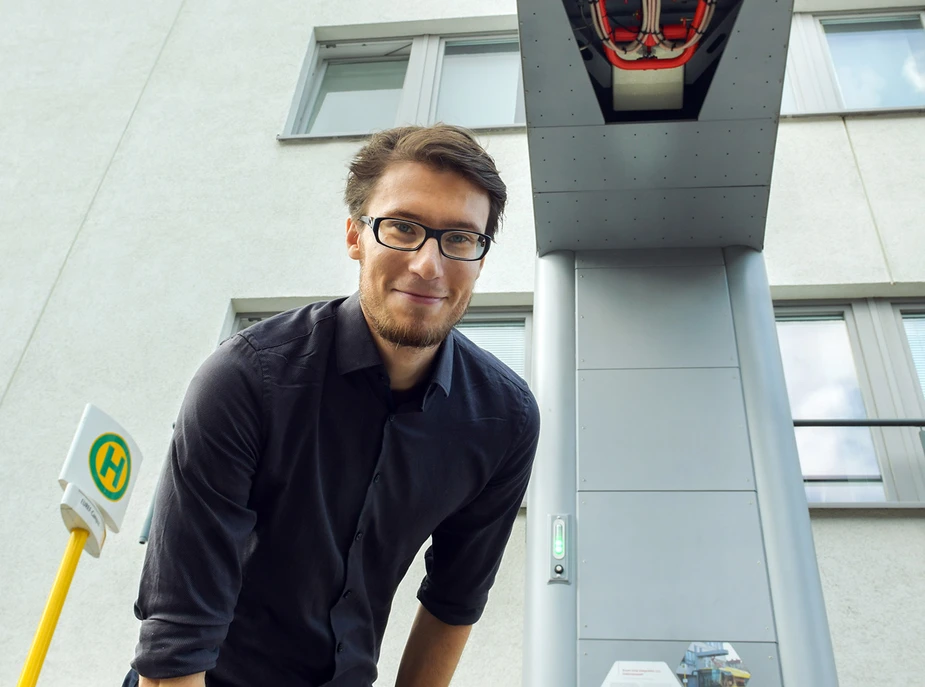Batteries vs. fuel cells
The Reiner Lemoine Institute compiled an overview of the advantages and disadvantages
Over the past few years, traffic and transportation are Germany’s only sectors where greenhouse gas emissions are increasing. Switching to electric cars is an important countermeasure to this trend. There are currently two available models: batteries, or fuel cells equipped with hydrogen tanks. Reiner Lemoine Institute has been working on an overview of the advantages and disadvantages. Normen Pieniak and his colleagues are currently also looking at how to advance the electrification of Berlin’s bus fleet.
People travelling between the stations Südkreuz and Zoologischer Garten might have caught a glimpse the new electric buses of the BVG, Berlin’s main public transport company. Four of these models have recently been tested on the 204 line. Researchers are now looking at the conditions needed to advance the electrification of Berlin’s high-frequency bus service (MetroBus). ‘The most important thing is battery charging that is as quick and flexible as possible,’ says Norman Pieniak. The mechanical engineer is head of the Municipal Mobility team at Reiner Lemoine Institute (RLI), which has been working together on this project with Technical University Berlin (TU) and Berliner Verkehrsbetriebe (BVG).
The institute was founded in 2010 by its late eponym, Reiner Lemoine, whose aim was to create a more liveable future for all people. ‘His goal was to contribute to the transition to cleaner energy,’ says Pieniak. The research at the institute does not use laboratories. To find out which strategies and technologies are economically and ecologically sound, its team conducts studies based on calculations and expert interviews. For more technical studies, they work together with partners at universities or private companies.
For the bus project in Berlin, 15 articulated buses were equipped with electric engines and batteries. The researchers then examined what type of energy supply concept is needed to keep the buses going in the harsh environment of big city traffic with its traffic jams, delays, and line closures. The requirements for charging stations are complex because quick charging requires a high output of more than 300 kilowatts, which is a burden on the local power grid. ‘On the one hand, we must find out where it is reasonable to set up charging stations for buses, and then where it is possible. On the other hand, we investigate if they can be powered by local renewable energy facilities, or integrated in smart grids with stationary storage, which regulate consumption and production depending on energy demands,’ says Pieniak. This requires close communication with energy providers and the local authorities.
In addition to costs for procurement and operation, range and charging capacity of the buses are pivotal aspects when evaluating battery-driven electric vehicles. Based on the RLI’s study, in 98 percent of the cases, a 100-km range and the currently still patchy charging station network could be enough for most users, as long as their home and workplace as well as commercial routes provide the necessary infrastructure. Today’s range of 350 to 400 kilometres makes these solutions suitable for long distances. None of these aspects apply to vehicles powered by fuel cells because they are much more like conventional cars. However, petrol stations for hydrogen are by far not as common as those for petrol, diesel, and so on.
Secondly, fuel-cell-powered vehicles do not have negative effects on the power grid. While the production of hydrogen as a fuel through electrolysis requires comparably high amounts of energy, location and performance are relatively flexible. Producing hydrogen from electric energy is seen as a promising option to store energy from renewable sources. Fuel cell technology could play a very important role for Germany’s future economy.
According to the RLI, opinions differ as to how a high amount of battery-powered vehicles puts pressure on the grid, or as to how – applying sound management - they could be used as storage vessels for excess regenerative energy. In any case, the researchers are mindful of the issue of resources. Battery production relies on the availability of certain chemical elements like lithium and so future shortages must also be considered.
Looking at all these aspects from a bird’s eye view, it becomes clear that the long-term transformation of traffic and mobility, a goal that was recently reiterated by minister of the environment Svenja Schulze, must take diverse arguments and complex ramifications into account. There is no simple response to the issue of batteries vs. fuel cells, says Norman Pieniak: ‘Both have their strengths and should be used accordingly.’
By Dr. Uta Deffke for Adlershof Journal
